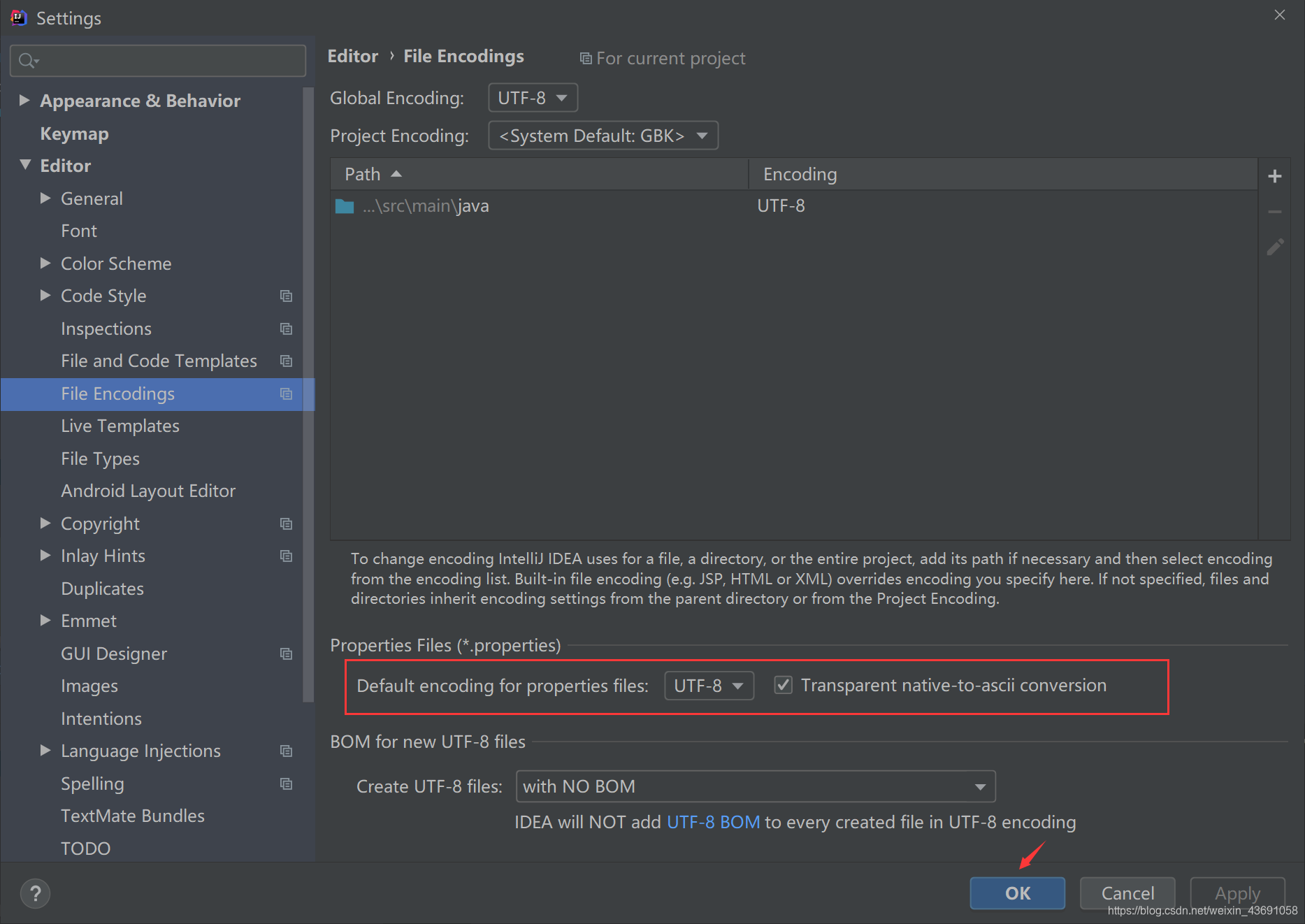文章目录
Spring Boot的配置文件
1.全局配置文件
Spring Boot时,很多启动所需要的配置在底层都为我们默认配置好了,但是如果我们有对默认配置不满意的地方,我们就需要修改配置文件。在类路径下会有一个application.properties或application.yml文件,这两个文件都会被Spring Boot当做全局配置文件。
- 全局配置文件名字是固定的都是
application,只是后缀有.properties和.yml - 位置:
src/main/resources目录或者类路径/config下。 - 作用:修改Spring Boot自动配置的默认值。
2.yml介绍
以前的配置文件大多采用.xml的文件。YML(YAML Ain’t Markup Language)属于一种比较新型的文件,以数据为中心,比json、xml等更适合做配置文件。 另外Spring Boot使用 snakeyaml 解析yml文件。
比较一下为服务器更换端口号的写法:
<server>
<port>8081<port>
</server>
server:
port: 8081
可以明显的看到第二种yml版的比第一种xml版的更加简洁。
2.1yml基本语法
k:(空格)v:表示一对键值对。
- 以空格的缩进来控制层级关系,只要是左边对齐的一列数据,都是同一个层级的。
- 属性和值大小写敏感。
server:
port: 8181
path: /hello
2.1.1字面量
k:v
- 数字、字符串、布尔、日期直接写
- 字符串:默认不使用引号,可以使用单引号或者双引号,单引号原样输出,双引号会对特殊字符进行转义。字符串可以写成多行,从第二行开始,必须有一个单空格缩进。换行符会被转为空格。
2.1.2对象(Map)
对象的一组键值对和Map类似,使用冒号分隔。如:username: admin。
普通写法
friends:
name: zhangsan
age: 20
行内写法
friends: {name: lisi,age: 19}
2.1.3数组(list、set)
连词线(-)开头的行,构成一个数组,[]为行内写法。
普通写法
# 相当于var pets = [ 'cat','dog','pig'];
pets:
- cat
- dog
- pig
行内写法
pets: [cat,dog,pig]
3.配置文件值注入
JavaBean组件
@Component
@ConfigurationProperties(prefix = "person")
public class Person {
private String name;
private Integer age;
private Boolean boss;
private Date birth;
private Map<String,Object> maps;
private List<Object> lists;
private Dog dog;
//省略setter、getter与toString方法
}
yml配置文件
person:
name: 张三
age: 18
boss: false
birth: 2020/1/13
maps: {k1: v1,k2: v2}
lists:
- 李四
- 王五
dog:
name: 旺旺
age: 2
properties配置文件
person.name=张三
person.age=18
person.birth=2020/12/12
person.boss=false
person.maps.k1=v1
person.maps.k2=15
person.lists=a,b,c
person.dog.name=大黄
person.dog.age=3
想要使上面yml或properties中组件中的属性和配置中的值一一绑定,需要在组件JavaBean中使用@ConfigurationProperties(prefix = "person")注解。
@ConfigurationProperties注解:告诉SpringBoot将本类中的所有属性和配置文件中相关的配置进行绑定,前提必须是容器中的组件。即需要先使用@Component将JavaBean加入到IoC容器中。
绑定时导入配置文件处理器,这样以后编写yml文件就有提示了:
<!--导入配置文件处理器-->
<dependency>
<groupId>org.springframework.boot</groupId>
<artifactId>spring-boot-configuration-processor</artifactId>
<optional>true</optional>
</dependency>
3.1配置properties配置文件时的编码问题
IDEA默认使用UTF-8编码,properties使用的是ASCII码,需要进行,编码转换:

3.2@ConfigurationProperties与@Value的区别
@Value的写法
@Value("${person.name}")
private String name;
@Value("#{11*2}")
private Integer age;
@Value("true")
private Boolean boss;
| 两者比较 | @ConfigurationProperties | @Value |
|---|---|---|
| 功能 | 批量注入配配置文件中的属性 | 一个个指定 |
| 松散绑定(松散语法) | 支持 | 不支持 |
| SpEL | 不支持 | 支持 |
| JSR303数据校验 | 支持(需要添加@Validated注解) | 不支持 |
| 复杂类型封装 | 支持 | 不支持 |
取舍问题:如果我们只是在某个业务逻辑中需要获取一下配置文件中的某项值,使用@Value。如下
@RestController
public class HelloController {
@Value("${person.name}")
private String name;
@RequestMapping("/say")
public String sayHello() {
return "Hello " + name;
}
}
而如果专门写了一个JavaBean来和配置文件进行映射,使用@ConfigurationProperties。
3.3@PropertySource和@ImportResource
@PropertySource:加载指定的配置文件。
@ConfigurationProperties(prefix = "person")默认加载的是全局配置文件,使用@PropertySource(value = {"classpath:person.properties"})可以加载指定配置文件。
@ImportResource:导入Spring的配置文件,让配置文件生效。
- Spring Boot中默认没有Spring的配置文件,想让Spring配置生效,需要使用此注解将Spring配置加载进来。
@ImportResource(locations = {"classpath:beans.xml"})
Spring Boot推荐的为容器中添加组件的方式是下面的全全注解的方式。
@Configuration
public class MyAppConfig {
@Bean
public HelloService helloService(){
return new HelloService();
}
}
4.配置文件随机数和占位符
配置文件中可以使用随机数:
${random.value}、${random.int}、${random.long}、${random.int(10)}、${random.int[1024,65546]}
占位符获取之前配置的值,如果没有可以使用默认值。
person.name=张三${random.uuid}
person.age=${random.int}
person.birth=2020/12/12
person.boss=false
person.maps.k1=v1
person.maps.k2=15
person.lists=a,b,c
person.dog.name=${person.hello:hello}_dog
person.dog.age=3
5.Profile
Profile是Spring用来做多环境支持的。可以通过激活、指定参数等方式快速切换环境。
5.1多profile形式
在主配置文件编写时,使用带这样的文件名:application-dev.properties、application-prod.properties,可以实现动态的切换环境。
- 当有多个主配置文件时,默认加载
application.properties。
5.2多profile文档块模式
server:
port: 8081
spring:
profiles:
active: dev
---
server:
port: 8082
spring:
profiles: dev
---
server:
port: 8083
spring:
profiles: pro
5.3激活方式
(1)配置文件激活
使用spring.profiles.active=dev的方式进行激活。
(2)命令行激活
使用:--spring.profiles.active=dev

除了上述使用IDEA可视化工具来运行,还可以将项目打包成jar,使用java -jar spring-boot-02-config-0.0.1-SNAPSHOT.jar --spring.profoles.active=dev运行jar包的方式。
(3)JVM参数
虚拟机参数:–Dspring.profiles.active=dev。

6.配置文件加载位置与顺序
springboot启动会扫描以下位置的application.properties或application.yml文件作为Spring Boot 的默认配置文件。
-file:./config/
-file:./
-classpath:/config/
-classpath:/
优先级由高到低,高优先级的配置会覆盖低优先级的配置。
Spring Boot会从这四个位置全部加载主配置文件,且互补配置。
除了应用内部,SpringBoot也可以从以下位置加载配置,优先级从高到低,高优先级的配置覆盖低优先级的配置,所有的配置会形成互补。
(1)命令行参数。
(2)来自java:comp/env的jndl属性。
(3)Java系统属性,(System.getProperties())。
(4)操作系统环境变量。
(5) RandomValuePropertySource配置的random.*属性值
(6) jar包外部的application-{profile}.properties或application.yml(带spring.profile)配置文件。
(7) jar包内部的application-{profile}.properties或application.yml(带spring.profile)配置文件。
(8) jar包外部的application.properties或application.yml(不带spring.profile)配置文件。
(9) jar包内部的application.properties或application.yml(不带spring.profile)配置文件。
(10) @Configuration注解类上的@PropertySource。
(11) 通过SpringApplication.setDefaultProperties指定的默认属性。
7.自动配置原理☆
①SpringBoot启动时会默认加载大量的自动配置类。
**②这些自动配置类中如果没有我们需要的组件,就需要在配置文件中指定这些属性的值。
③给容器中自动配置类添加组件时,会从properties类中获取某些属性。我们可以在配置文件中指定这些属性的值。
SpringBoot启动时,加载主配置类,开启了自动配置功能。@EnableAutoConfiguration注解的作用:利用@EnableAutoConfigurationImportSelector(选择器)为容器导入一些组件。
List<String> configurations = getCandidateConfigurations(annotationMetadata,
attributes);//获取候选的配置
SpringFactoriesLoader.loadFactoryNames()- 扫描所有jar包类路径下的
META-INF/spring.factories文件。 - 把扫描到的文件的内容包装成properties对象。
- 从properties中获取到
EnableAutoConfiguration.class类(类名)对应的值,然后把他们添加在容器中。
将类路径下META-INF/spring.factories里边配置的所有@EnableAutoConfiguration的值加入到容器中。
# Auto Configure
org.springframework.boot.autoconfigure.EnableAutoConfiguration=\
org.springframework.boot.autoconfigure.admin.SpringApplicationAdminJmxAutoConfiguration,\
org.springframework.boot.autoconfigure.aop.AopAutoConfiguration,\
org.springframework.boot.autoconfigure.amqp.RabbitAutoConfiguration,\
org.springframework.boot.autoconfigure.batch.BatchAutoConfiguration,\
org.springframework.boot.autoconfigure.cache.CacheAutoConfiguration,\
org.springframework.boot.autoconfigure.cassandra.CassandraAutoConfiguration,\
org.springframework.boot.autoconfigure.cloud.CloudAutoConfiguration,\
org.springframework.boot.autoconfigure.context.ConfigurationPropertiesAutoConfiguration,\
org.springframework.boot.autoconfigure.context.MessageSourceAutoConfiguration,\
org.springframework.boot.autoconfigure.context.PropertyPlaceholderAutoConfiguration,\
org.springframework.boot.autoconfigure.couchbase.CouchbaseAutoConfiguration,\
org.springframework.boot.autoconfigure.dao.PersistenceExceptionTranslationAutoConfiguration,\
org.springframework.boot.autoconfigure.data.cassandra.CassandraDataAutoConfiguration,\
org.springframework.boot.autoconfigure.data.cassandra.CassandraRepositoriesAutoConfiguration,\
org.springframework.boot.autoconfigure.data.couchbase.CouchbaseDataAutoConfiguration,\
org.springframework.boot.autoconfigure.data.couchbase.CouchbaseRepositoriesAutoConfiguration,\
org.springframework.boot.autoconfigure.data.elasticsearch.ElasticsearchAutoConfiguration,\
org.springframework.boot.autoconfigure.data.elasticsearch.ElasticsearchDataAutoConfiguration,\
org.springframework.boot.autoconfigure.data.elasticsearch.ElasticsearchRepositoriesAutoConfiguration,\
org.springframework.boot.autoconfigure.data.jpa.JpaRepositoriesAutoConfiguration,\
org.springframework.boot.autoconfigure.data.ldap.LdapDataAutoConfiguration,\
org.springframework.boot.autoconfigure.data.ldap.LdapRepositoriesAutoConfiguration,\
org.springframework.boot.autoconfigure.data.mongo.MongoDataAutoConfiguration,\
org.springframework.boot.autoconfigure.data.mongo.MongoRepositoriesAutoConfiguration,\
org.springframework.boot.autoconfigure.data.neo4j.Neo4jDataAutoConfiguration,\
org.springframework.boot.autoconfigure.data.neo4j.Neo4jRepositoriesAutoConfiguration,\
org.springframework.boot.autoconfigure.data.solr.SolrRepositoriesAutoConfiguration,\
org.springframework.boot.autoconfigure.data.redis.RedisAutoConfiguration,\
org.springframework.boot.autoconfigure.data.redis.RedisRepositoriesAutoConfiguration,\
org.springframework.boot.autoconfigure.data.rest.RepositoryRestMvcAutoConfiguration,\
org.springframework.boot.autoconfigure.data.web.SpringDataWebAutoConfiguration,\
org.springframework.boot.autoconfigure.elasticsearch.jest.JestAutoConfiguration,\
org.springframework.boot.autoconfigure.freemarker.FreeMarkerAutoConfiguration,\
org.springframework.boot.autoconfigure.gson.GsonAutoConfiguration,\
org.springframework.boot.autoconfigure.h2.H2ConsoleAutoConfiguration,\
org.springframework.boot.autoconfigure.hateoas.HypermediaAutoConfiguration,\
org.springframework.boot.autoconfigure.hazelcast.HazelcastAutoConfiguration,\
org.springframework.boot.autoconfigure.hazelcast.HazelcastJpaDependencyAutoConfiguration,\
org.springframework.boot.autoconfigure.info.ProjectInfoAutoConfiguration,\
org.springframework.boot.autoconfigure.integration.IntegrationAutoConfiguration,\
org.springframework.boot.autoconfigure.jackson.JacksonAutoConfiguration,\
org.springframework.boot.autoconfigure.jdbc.DataSourceAutoConfiguration,\
org.springframework.boot.autoconfigure.jdbc.JdbcTemplateAutoConfiguration,\
org.springframework.boot.autoconfigure.jdbc.JndiDataSourceAutoConfiguration,\
org.springframework.boot.autoconfigure.jdbc.XADataSourceAutoConfiguration,\
org.springframework.boot.autoconfigure.jdbc.DataSourceTransactionManagerAutoConfiguration,\
org.springframework.boot.autoconfigure.jms.JmsAutoConfiguration,\
org.springframework.boot.autoconfigure.jmx.JmxAutoConfiguration,\
org.springframework.boot.autoconfigure.jms.JndiConnectionFactoryAutoConfiguration,\
org.springframework.boot.autoconfigure.jms.activemq.ActiveMQAutoConfiguration,\
org.springframework.boot.autoconfigure.jms.artemis.ArtemisAutoConfiguration,\
org.springframework.boot.autoconfigure.flyway.FlywayAutoConfiguration,\
org.springframework.boot.autoconfigure.groovy.template.GroovyTemplateAutoConfiguration,\
org.springframework.boot.autoconfigure.jersey.JerseyAutoConfiguration,\
org.springframework.boot.autoconfigure.jooq.JooqAutoConfiguration,\
org.springframework.boot.autoconfigure.kafka.KafkaAutoConfiguration,\
org.springframework.boot.autoconfigure.ldap.embedded.EmbeddedLdapAutoConfiguration,\
org.springframework.boot.autoconfigure.ldap.LdapAutoConfiguration,\
org.springframework.boot.autoconfigure.liquibase.LiquibaseAutoConfiguration,\
org.springframework.boot.autoconfigure.mail.MailSenderAutoConfiguration,\
org.springframework.boot.autoconfigure.mail.MailSenderValidatorAutoConfiguration,\
org.springframework.boot.autoconfigure.mobile.DeviceResolverAutoConfiguration,\
org.springframework.boot.autoconfigure.mobile.DeviceDelegatingViewResolverAutoConfiguration,\
org.springframework.boot.autoconfigure.mobile.SitePreferenceAutoConfiguration,\
org.springframework.boot.autoconfigure.mongo.embedded.EmbeddedMongoAutoConfiguration,\
org.springframework.boot.autoconfigure.mongo.MongoAutoConfiguration,\
org.springframework.boot.autoconfigure.mustache.MustacheAutoConfiguration,\
org.springframework.boot.autoconfigure.orm.jpa.HibernateJpaAutoConfiguration,\
org.springframework.boot.autoconfigure.reactor.ReactorAutoConfiguration,\
org.springframework.boot.autoconfigure.security.SecurityAutoConfiguration,\
org.springframework.boot.autoconfigure.security.SecurityFilterAutoConfiguration,\
org.springframework.boot.autoconfigure.security.FallbackWebSecurityAutoConfiguration,\
org.springframework.boot.autoconfigure.security.oauth2.OAuth2AutoConfiguration,\
org.springframework.boot.autoconfigure.sendgrid.SendGridAutoConfiguration,\
org.springframework.boot.autoconfigure.session.SessionAutoConfiguration,\
org.springframework.boot.autoconfigure.social.SocialWebAutoConfiguration,\
org.springframework.boot.autoconfigure.social.FacebookAutoConfiguration,\
org.springframework.boot.autoconfigure.social.LinkedInAutoConfiguration,\
org.springframework.boot.autoconfigure.social.TwitterAutoConfiguration,\
org.springframework.boot.autoconfigure.solr.SolrAutoConfiguration,\
org.springframework.boot.autoconfigure.thymeleaf.ThymeleafAutoConfiguration,\
org.springframework.boot.autoconfigure.transaction.TransactionAutoConfiguration,\
org.springframework.boot.autoconfigure.transaction.jta.JtaAutoConfiguration,\
org.springframework.boot.autoconfigure.validation.ValidationAutoConfiguration,\
org.springframework.boot.autoconfigure.web.DispatcherServletAutoConfiguration,\
org.springframework.boot.autoconfigure.web.EmbeddedServletContainerAutoConfiguration,\
org.springframework.boot.autoconfigure.web.ErrorMvcAutoConfiguration,\
org.springframework.boot.autoconfigure.web.HttpEncodingAutoConfiguration,\
org.springframework.boot.autoconfigure.web.HttpMessageConvertersAutoConfiguration,\
org.springframework.boot.autoconfigure.web.MultipartAutoConfiguration,\
org.springframework.boot.autoconfigure.web.ServerPropertiesAutoConfiguration,\
org.springframework.boot.autoconfigure.web.WebClientAutoConfiguration,\
org.springframework.boot.autoconfigure.web.WebMvcAutoConfiguration,\
org.springframework.boot.autoconfigure.websocket.WebSocketAutoConfiguration,\
org.springframework.boot.autoconfigure.websocket.WebSocketMessagingAutoConfiguration,\
org.springframework.boot.autoconfigure.webservices.WebServicesAutoConfiguration
每一个xxxAutoConfiguration都是容器中的一个组件,用他们来做自动配置。
以HttpEncodingAutoConfiguration为例解释自动配置原理:
@Configuration //表示这是一个配置类,可以给容器中添加组件.
@EnableConfigurationProperties(HttpEncodingProperties.class)//启用指定类的EnableConfigurationProperties功能;
//将配置文件和对应的HttpEncodingAutoConfiguration绑定起来,并把HttpEncodingProperties加到IoC容器中
@ConditionalOnWebApplication//判断当前配置类是否是web应用,true(生效),false(不生效)
@ConditionalOnClass(CharacterEncodingFilter.class)//判断当前项目有没有这个类;
//CharacterEncodingFilter是SpringMVC中进行乱码解决的过滤器.
@ConditionalOnProperty(prefix = "spring.http.encoding", value = "enabled", matchIfMissing = true)//判断配置文件中是否存在某个配置spring.http.encoding.enabled;
//如果不存在,判断也是成立的.即使我们配置文件中不配置spring.http.encoding.enable=true,也是默认生效的.
public class HttpEncodingAutoConfiguration {
//他已经和SpringBoot的配置文件映射了
private final HttpEncodingProperties properties;
//只有一个有参构造器的情况下,参数的值就会从容器中拿
public HttpEncodingAutoConfiguration(HttpEncodingProperties properties) {
this.properties = properties;
}
@Bean//为容器中添加一个组件,这个组件的某些值需要从properties中获取。
@ConditionalOnMissingBean(CharacterEncodingFilter.class)
public CharacterEncodingFilter characterEncodingFilter() {
CharacterEncodingFilter filter = new OrderedCharacterEncodingFilter();
filter.setEncoding(this.properties.getCharset().name());
filter.setForceRequestEncoding(this.properties.shouldForce(Type.REQUEST));
filter.setForceResponseEncoding(this.properties.shouldForce(Type.RESPONSE));
return filter;
}
根据不同的条件判断,决定这个配置类是否生效。一旦配置类生效,这个配置类就会为IoC容器中添加各种组件,这些组件的属性是从对应的properties类中获取的,这些类里面的属性又是和配置文件绑定的。所以我们能够手动配置的属性都是来自于某功能的properties类。
8.@Conditional注解和自动配置报告
8.1@Conditional派生注解
作用:必须是@Conditional指定的条件成立,才给容器中添加组件,配置里的所有内容才生效。
| @Conditional扩展注解 | 作用(判断是否满足当前指定条件) |
|---|---|
| @ConditionalOnJava | 系统的java版本是否符合要求 |
| @ConditionalOnBean | 容器中存在指定Bean |
| @ConditionalOnMissingBean | 容器中不存在指定Bean |
| @ConditionalOnExpression | 满足SpEL表达式指定 |
| @ConditionalOnClass | 系统中有指定的类 |
| @ConditionalOnMissingClass | 系统中没有指定的类 |
| @ConditionalOnSingleCandidate | 容器中只有一个指定的Bean,或者这个Bean是首选Bean |
| @ConditionalOnProperty | 系统中指定的属性是否有指定的值 |
| @ConditionalOnResource | 类路径下是否存在指定资源文件 |
| @ConditionalOnWebApplication | 当前是web环境 |
| @ConditionalOnNotWebApplication | 当前不是web环境 |
| @ConditionalOnJndi | JNDI存在指定项 |
8.2自动配置报告
自动配置类必须在一定条件下才生效,如何才能知道哪些自动配置类生效哪些不生效呢?
可以在全局配置properties文件中通过debug=true属性,来让控制台打印自动配置报告。


通过这个属性,我们可以很方便的看到哪些自动配置启用了,哪些自动配置未启用。
